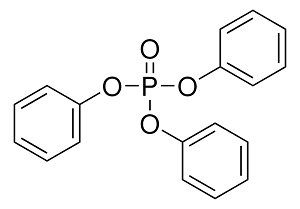Triphenyl Phosphate

Product Description
Triphenyl phosphate (TPP) is a chemical compound with various industrial applications.
Product:
Triphenyl Phosphate
CAS:
115-86-6
Synonym:
Phosphoric acid, triphenyl ester; Triphenoxyphosphine oxide
Structure:

Typical Characteristics
Appearance
Colorless crystalline powder
Boiling point
370 °C
Density
1.2055 g/cm3
Flash Point
220 °C
Melting point
48-50 °C
Molecular Weight
326.28
Odor
Phenol-like odor
Purity
≥99%
Refractive index
1.550
Uses, Applications & Markets
Key applications
get a quote
We Offer Triphenyl Phosphate
in various grades
A few of the grades available are listed below:



Triphenyl Phosphate used in many
industry applications
Triphenyl phosphate (TPP) is a chemical compound with various industrial applications. Here are some of its industrial uses:
- Flame Retardants: TPP is widely used as a flame retardant additive in plastics, polymers, and synthetic materials. It acts as a flame retardant by releasing phosphorus-containing compounds that inhibit combustion and reduce the spread of flames in case of fire.
- Plasticizers: It is utilized as a plasticizer in the production of flexible PVC (polyvinyl chloride) and other polymer materials. TPP improves the flexibility, durability, and processability of plastics, making them suitable for applications such as wire insulation, flooring, and automotive parts.
- Lubricant Additives: TPP may be used as an additive in lubricating oils and greases to improve their performance and lubrication properties. It helps reduce friction, wear, and heat generation in mechanical systems, extending the lifespan of machinery and equipment.
- Hydraulic Fluids: It is employed in the formulation of hydraulic fluids for hydraulic systems and equipment. TPP-based hydraulic fluids provide lubrication, corrosion protection, and thermal stability in high-pressure hydraulic systems used in industrial machinery and hydraulic equipment.
- Textile Flame Retardants: TPP is used in the textile industry for flame-retardant treatments of fabrics and textiles. It can be applied as a coating or treatment to enhance the fire resistance of textiles used in upholstery, curtains, carpets, and protective clothing.
- Adhesives and Sealants: It may be added to adhesives and sealants formulations as a flame retardant and plasticizing agent. TPP helps improve the fire resistance and mechanical properties of adhesive bonds and sealant joints in construction, automotive, and aerospace applications.
- Paints and Coatings: TPP is used as a flame retardant additive in paints, coatings, and varnishes to enhance their fire resistance and safety properties. It can be incorporated into architectural coatings, industrial coatings, and intumescent coatings for structural steel.
- Electronics: It is utilized in the electronics industry for flame-retardant applications in electronic devices and components. TPP-based flame retardants may be used in circuit boards, electrical enclosures, and insulation materials to meet safety standards and regulations.
- Rubber Products: TPP may be used as a flame retardant and plasticizer in the production of rubber products such as gaskets, seals, and automotive components. It helps improve the fire resistance and mechanical properties of rubber materials.
- Construction Materials: TPP is used in the construction industry for flame-retardant treatments of building materials such as insulation foams, roofing materials, and structural elements. It helps enhance the fire safety of buildings and infrastructure.